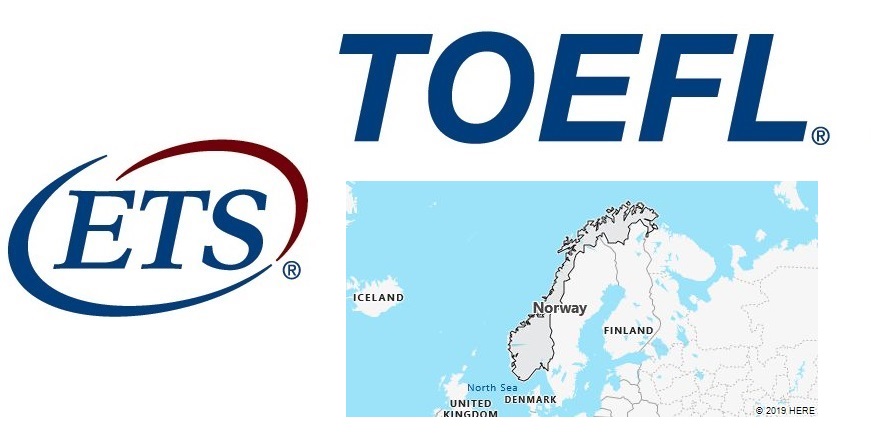The TOEFL iBT test is offered in this location.
The list below shows testing regions, fees and dates as of February 15, 2019, but availability may change when you register. Fees are shown in US$ and are subject to change without notice.
| Region | Testing Format | Fee | Test Dates |
|---|---|---|---|
| Oslo | TOEFL iBT | $290 $290 $290 $290 $290 $290 $290 $290 $290 $290 $290 $290 $290 $290 $290 $290 |
Fri., Mar 08, 2019 Sat., Mar 09, 2019 Sat., Mar 16, 2019 Sat., Mar 30, 2019 Fri., Apr 05, 2019 Sat., Apr 13, 2019 Sat., May 04, 2019 Fri., May 10, 2019 Sat., May 11, 2019 Sat., May 18, 2019 Sat., Jun 01, 2019 Sat., Jun 15, 2019 Sat., Jun 29, 2019 Fri., Jul 12, 2019 Sat., Jul 13, 2019 Sat., Jul 27, 2019 |
Norway Overview
Norway is a constitutional monarchy in Northern Europe. The land to the west of Scandinavia has a large north-south extension and inside by Mountains (Scandes embossed) with harsh climates. The Atlantic coast is richly indented by numerous fjords and archipelagos. While the north on the Arctic Circle and the high mountain regions are almost deserted, a third of the population is concentrated in the south and the Oslofjord. The Sami minority live in the northeast, often still in their traditional way of life as fishermen and reindeer herders. Society is characterized by a high degree of consensus, openness and equality. The tax-financed welfare system includes medical care, social benefits and training at the highest level. Life expectancy is among the highest in the world. By extracting oil and natural gas off the coast, Norway has risen from a poor agricultural state to one of the richest countries in the world. A large part of the revenues from the state oil industry is invested as a reserve in the Norwegian State Fund. This world’s largest sovereign wealth fund is supposed to guarantee the economic security of the citizens after the oil reserves are exhausted. The country was from 8-11. Century starting point for the forays of the Vikings until Christianization forced them to give up their way of life. Later it was under foreign rule from Denmark and Sweden, which long hindered the development of its own culture. In 1905 Norway became independent. The country, intent on its independence, is not a member of the EU, but part of the Schengen area.
Country facts
- Official name: Kingdom of Norway
- License plate: N
- ISO-3166: NO, NOR (578)
- Internet domain:.no
- Currency: 1 Norwegian krone (nkr) = 100 Øre
- Area: 385 178 km²
- Population (2019): 5.3 million
- Capital: Oslo
- Official language (s): Norwegian and Sami (equivalent to Norwegian in some municipalities in the administrative districts of Troms, Finnmark, Nordland and Nord-Trøndelag)
- Form of government: Parliamentary monarchy
- Administrative division: 18 provinces
- Head of State: King Harald V.
- Head of Government: Erna Solberg
- Religion (s) (2016): Christians (71% Lutherans, 3% Catholics, 4% other Christians), 3% Muslims, 19% other / n / a
- Time zone: Central European Time
- National holiday: May 17th
Location and infrastructure
- Location (geographical): Northern Europe
- Position (coordinates): between 57 ° 57 ‘and 71 ° 11’ north latitude and 4 ° 30 ‘and 31 ° 10’ east longitude
- Climate: On the coast oceanic, otherwise cold and humid climate
- Highest mountain: Galdhøppigen (2,469 m)
- Road network (2018): 94,900 km
- Railway network (2019): 4,200 km
Population
- Annual population growth (2021): 0.8%
- Birth rate (2021): 12.1 per 1000 inh.
- Death rate (2021): 8.0 per 1000 inh.
- Average age (2020): 39.5 years
- Average life expectancy (2021): 82.4 years (men 80.2; women 84.6)
- Age structure (2020): 18.0% younger than 15 years, 17.4% older than 65 years
- Literacy rate (15 year olds and older): N / A
- Mobile phone contracts (pre-paid and post-paid) (2018): 107 per 100 pop.
- Internet users (2019): 98 per 100 pop.
Economy
- GDP per capita (2019): US $ 75,294
- Total GDP (2019): $ 403 billion
- GNI per capita (2019): US $ 82,500
- Education expenditure (2017): 7.9% of GDP
- Military expenditure (2020): 2.0% of GDP
- Unemployment rate (15 years and older) (2019): 3.3%
Climate
The climate is determined by the latitude and the location within the west wind zone. While the climatic north-south contrast is small, the difference between the west under the influence of the Gulf Stream and the continentally influenced east is all the more pronounced. In its sheltered location, Oslo has the highest July mean in Scandinavia with 17.3 ° C. The windward side of the mountains is rich in precipitation due to the rain-bringing westerly winds (Bergen 2,250 mm annual precipitation, in contrast in Oslo 763 mm, in Røros 480 mm and in Karasjok 340 mm). The snow line is lowest near the coast (in southern Norway at around 1,250 m above sea level and in eastern Norway at around 1,600–1,700 m above sea level) and rises in the interior to a height of 2,000 m. glacier cover a total of about 3900 km 2, often in the form of plateau glaciers of the Icelandic-Norwegian type (Jostedalsbre).
The midnight sun is in Bodø from June 3rd to July 7th (34 days), in Svolvær (Lofoten) from May 29th to 15th, in Tromsø from May 20th to 22nd, in Hammerfest from May 15 to July 26 and at the North Cape from May 13 to July 29 (77 days). Polar night is in Bodø from December 14th to 28th (14 days), in Svolvær from December 5th to January 9th, in Tromsø from November 25th to January 18th, in Hammerfest from November 20th. to 22. 1. and at the North Cape from 18. 11. to 24. 1. (67 days).

